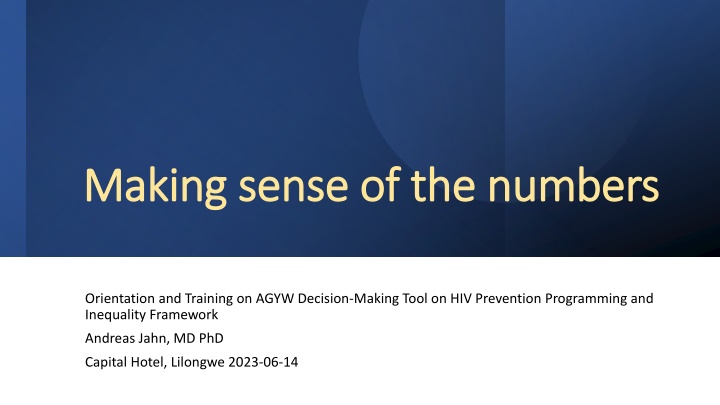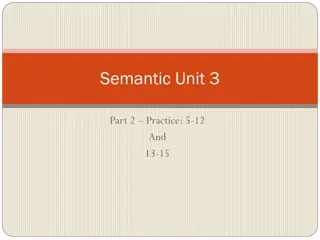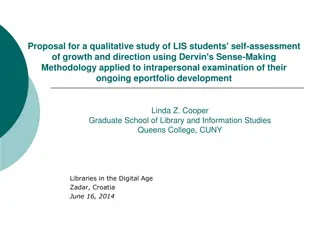Making sense of the numbers Making sense of the numbers
HIV prevention program focused on AGYW decision-making processes and inequalities in Lilongwe, covering key measures, population segments, and intervention effectiveness using data-driven approaches. The content features images depicting HIV statistics and measures for understanding, impact assessment, and resource allocation.
Download Presentation

Please find below an Image/Link to download the presentation.
The content on the website is provided AS IS for your information and personal use only. It may not be sold, licensed, or shared on other websites without obtaining consent from the author.If you encounter any issues during the download, it is possible that the publisher has removed the file from their server.
You are allowed to download the files provided on this website for personal or commercial use, subject to the condition that they are used lawfully. All files are the property of their respective owners.
The content on the website is provided AS IS for your information and personal use only. It may not be sold, licensed, or shared on other websites without obtaining consent from the author.
E N D
Presentation Transcript
Making sense of the numbers Making sense of the numbers Orientation and Training on AGYW Decision-Making Tool on HIV Prevention Programming and Inequality Framework Andreas Jahn, MD PhD Capital Hotel, Lilongwe 2023-06-14
HIV negative population: At risk of HIV infection Target for primary prevention interventions HIV positives not on ART Source of new infections Target for treatment as prevention HIV positives on ART No risk of new infections Target for retention and adherence support
Key measures Key measures How many? New infections, deaths, PLHIV, How common? Prevalence, incidence, mortality, How effective? Odds ratio, rate ratio, Attributable proportion (% reduction / increase), What impact? Is it worth the investment? Cost per infection averted,
How many What is in the numerator What is in the denominator PLHIV currently alive in defined population At specific point in time (31st Dec 2022) None PLHIV Events in defined population None New infections, During specific period (in 2023) new deaths
How common What is in the numerator What is in the denominator PLHIV currently alive in defined population Total population (HIV pos and neg) in Malawi At specific point in time (31st Dec 2022) Prevalence At specific point in time (31st Dec 2022) New infections in defined population During specific period (in 2023) Total population at risk of getting infected in Malawi = only HIV negatives Length of period e.g. 1 year Incidence Total deaths from HIV in defined population During specific period (in 2023) Total population living in Malawi (HIV pos and neg) Length of period e.g. 1 year Mortality
How effective What is in the numerator What is in the denominator People with the intervention: People without the intervention: Odds ratio Infected people divided by uninfected people Infected people divided by uninfected people At specific point in time At specific point in time People with the intervention: People without the intervention: ??? ?????????? ?????? ????? ??????????? ??????????? ?????? New infections during observation period Incidence rate ratio ??? ?????????? ?????? ????? ??????????? ??????????? ?????? New infections during observation period
What impact What is in the numerator What is in the denominator People who have been reached with the intervention: Total population in need of the intervention: Attributable proportion Odds or incidence rate Odd or incidence rate Background odds or incidence that happened without the intervention Impact depends on: Strength of effect of the intervention Scalability / coverage of an intervention
Is it worth the investment What is in the numerator What is in the denominator Average cost per person reached with the intervention Total infections or deaths averted by the intervention Cost per infection / death averted Can be one-off or cost per period Cost-effectiveness depends on: Average cost per person reached Strength of effect of the intervention There is often opportunity cost: investment in one intervention may weaken others
How much is 0.3% annual HIV incidence? 3 in a group of 1000 uninfected people get infected during a 1-year period
What is the average transmission risk? Contact with HIV positive person, not virally suppressed Exposure type Per exposure Cumulative risk 100 exposures Needle sharing 0.63% 47% Needle stick 0.23% 21% Receptive anal intercourse 1.38% 75% Insertive anal intercourse 0.11% 10% Receptive penile-vaginal intercourse 0.08% 8% Insertive penile-vaginal intercourse 0.04% 4% Receptive penile-vaginal intercourse with STI 0.24% 21% Insertive penile-vaginal intercourse with STI 0.12% 11% Oral intercourse 0-0.04% 0-4%
HIV Prevention Interventions Biomedical ART PMTCT VMMC PrEP PEP Condoms Microbicides (HIV testing) Non-Biomedical SBCC CSE KP outreach Community mobilization Peer support Norms change PWID needle exchange PWID opiate substitution Structural Cash transfer Education Income/ asset generation GBV care
How do non-biomedical prevention interventions work? Delayed sexual debut Less frequent intercourse Fewer different partners More condom use Less risky partner choice (age difference, promiscuity, STI, etc.) Increased uptake of biomedical interventions
How effective are prevention interventions? Intervention Risk reduction ART (viral suppression) 100% PEP (when completed) 80% Oral PrEP MSM (average adherence) 77% Oral PrEP heterosexual (average adherence) 55% Injectable PrEP (CAB-LA) 93% Condoms heterosexual (consistent use) 80% Condoms MSM 63-91% VMMC heterosexual (protection for the man) 50-60% VMMC (protection for the woman) inconclusive VMMC for MSM inconclusive KP outreach (through increased condom use) 10-45% DREAMS package (South Africa) <5%
How many infections averted by giving oral PrEP for 1 year to 1000 people with 0.3% incidence? 1 infections averted: 55% effectiveness for 3 people
Why does risky behavior HIV incidence? Why does risky behavior HIV incidence? Risk of HIV acquisition depends strongly on probability of contact with viraemic person (population viral load) Prevalence of viraemic adults in Malawi 2000: 13.1% 2023: 0.4% Promiscuous condomless sex in 2000 was much riskier than in 2023 Location matters: CLOVE study (Blantyre 2021): 2% of general population at health facility viraemic 4% of population attending venues viraemic
Why do we need HIV estimates and mathematical modelling? Key indicators cannot be directly measured HIV incidence, impact of prevention interventions: would need huge cohort study with repeated HIV testing Routine recency surveillance finds <5% of estimated new infections PLHIV cannot be directly enumerated: extrapolation from prevalence survey (small sample) applied to demographic projection Incomplete death reporting, causes mostly unknown Time trends and changes need past and future estimates Scenarios, impact and cost-effectiveness can only be explored with model calculations
How do we know its true? Human biases Availability bias: If a recent event or a vivid example is easily recalled, it may be overestimated in terms of probability or importance. Optimism bias: we believe that positive events are more likely to happen to them while negative events are less likely. Loss aversion: Stronger emotional response to losses than to gains. Potential losses are perceived as more significant than they objectively are. Herd mentality: we follow the actions and opinions of the majority. Cognitive dissonance: conflicting information or evidence that challenges existing beliefs or behaviors causes discomfort, leading us to downplay or ignore the evidence. Lack of statistical reasoning: Probability, uncertainty, and complex data can be counter-intuitive and challenging to grasp Emotional factors: Strong emotions can cloud judgment
Making use of estimates and data Program managers should make rational evidence-based decisions Know your cognitive biases Follow the science Objectively assess quality of scientific evidence GRADE criteria, etc. Look at uncertainty bounds / confidence intervals 100% certain that HIV prevalence is between 0-100%: useful? 95% certain adult 15+ prevalence in 2023 is between 7.3-8.2%: useful! Triangulate data and information Consider opportunity cost : are investments made for maximum population benefit?























